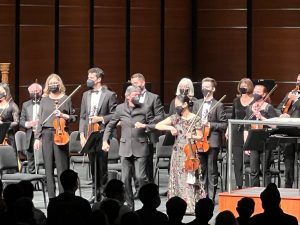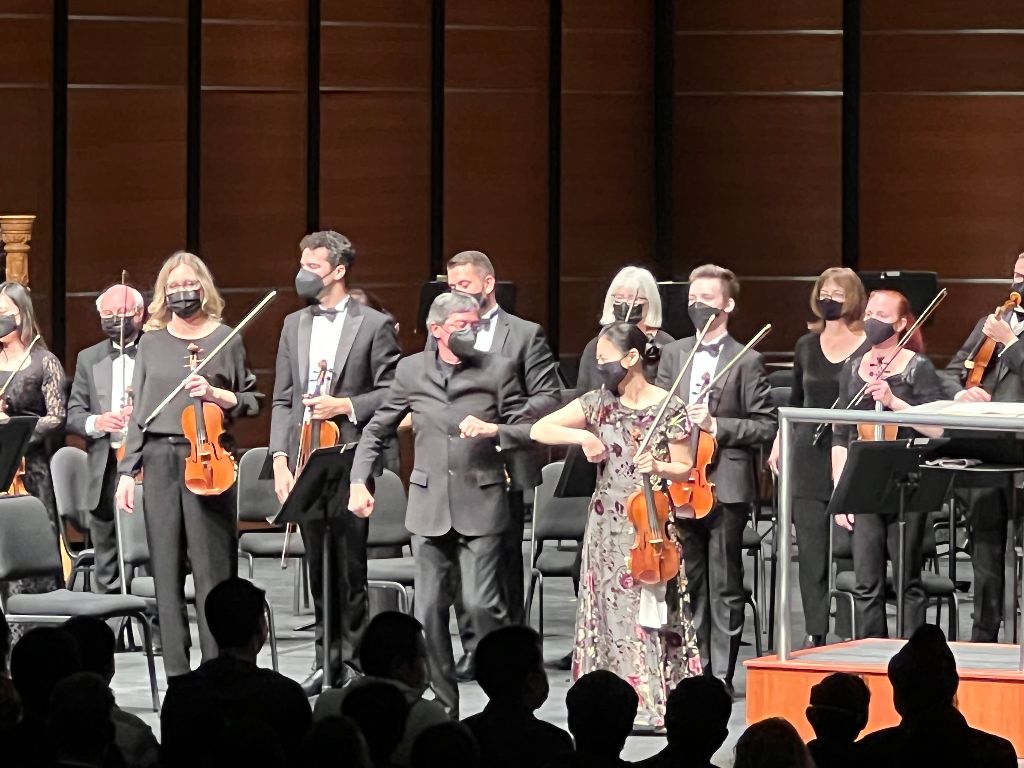One of the world’s foremost violinists, Midori, graced the stage at the Long Center for her third appearance with the Austin Symphony Orchestra. Concert goers with a long memory will recall her previous performances here 10 and 20 years ago. Conductor Peter Bayle told the audience he was not going to wait another decade to have her here again.
This time she tackled a piece by Jean Sibelius, Violin Concerto in D minor. Its first incarnation was in 1903 in Helsinki, but it received such a poor reception that Sibelius withdrew that score and revamped it. The new version premiered in Berlin in 1905.
While it is technically difficult, especially in the first and third movements, the concerto is also difficult to like. Midori certainly wrung every nuance out of the score, but even she could not generate more than a very polite response from the audience. This was particularly evident after her brief solo encore, which elicited cheers and loud applause. That unannounced piece, evocative of whirling birds at a seashore, was a breath of fresh air after the Sibelius.
One could almost hear her magnificent 1734 violin groan in the third movement as it was forced to emit sounds never heard in the 18th century. The angst-driven notes were painful to my ears, the sort of music that might be appropriate while perusing a fantastical book by Edward Gorey. By contrast the first movement opened with delightfully sweet notes, a prelude to a confectioner’s delight of musical notes that only switched register after a couple of explicit drum beats.
The sombre opening of the second movement developed into a deeply troubled mood-piece, a sort of musical evocation of Sturm and Drang. Its saving grace was ending on a touchingly sweet note from Midori’s violin but one music critic, known for his harsh analysis, found the physical movements of Midori quite distracting, “like a fiddler at a hoe-down.”
The concert opened with a rare form of music known as a ‘fantastic scherzo,’ other examples of which are the Overture to Midsummer Nights’ Dream by Mendelssohn and the Sorcerer’s Apprentice by Paul Dukas. This form of music is characterized by a light-hearted piece that makes one hesitate about what the composer is going to do next.
In this case Austin Symphony Orchestra gave a great interpretation of Fantasticke Scherzo by Josef Suk, a composer known only to diehard classical music buffs. Most of his work was somewhat dreary. This was only composed by Suk in 1892 at the direction of his musical mentor Antonin Dvořak, who asked him “to produce something cheerful…give us some respite from these eternal monuments in minor keys.” Shortly after he did this, his wife and her father, Dvořak, died. He returned to funeral compositions, so this Scherzo represents his only popular composition. The concert also included Dvořak’s Symphony No. 3 from 1872. Its rather long second movement, redolent of a funeral march, would have been appreciated by Suk.
Following a sprightly opening, a dash of whimsey is immediately apparent in Suk’s Scherzo. A bird-like passage follows; once can see them flitting from one sun-dappled branch to another. The Scherzo would have made a fine soundtrack to the 1949 film My Secret Garden, in the scene where a young Maureen O’Hara progresses through a walled garden that she had laboured to bring back to life. The Scherzo evokes the lilacs, daffodils and other blossoms she planted as it concludes in a bubbly efflorescence.
The concert is being performed again tonight, at the Long Centre. A special event celebrating 25 years of Peter Bayle at Austin Symphony will be held March 24, 2022. Individual tickets at $1,000 are available at AustinSymphony.org

